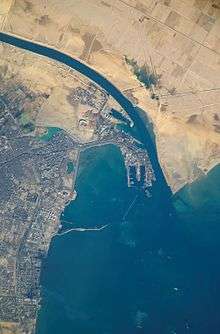River mouth
A river mouth is the part of a river where the river debouches into another river, a lake, a reservoir, a sea, or an ocean.[1]

Water motion
The water from a river can enter the receiving body in a variety of different ways.[1] The motion of a river is influenced by the relative density of the river compared to the receiving water, the rotation of the earth, and any ambient motion in the receiving water, such as tides or seiches.[2]
If the river water has a higher density than the surface of the receiving water, the river water will plunge below the surface. The river water will then either form an underflow or an interflow within the lake. However, if the river water is lighter than the receiving water, as is typically the case when fresh river water flows into the sea, the river water will float along the surface of the receiving water as an overflow.
Alongside these advective transports, inflowing water will also diffuse.[1]
Landforms
At the but of a river, the change in flow condition can cause the river to drop any sediment it is carrying. This sediment deposition can generate a variety of landforms, such as deltas, sand bars, spits, and tie channels.[3]
Cultural influence
Many places in the United Kingdom take their names from their positions at the mouths of rivers, such as Plymouth (i.e. mouth of the Plym River), Sidmouth (i.e. mouth of the Sid River), and Great Yarmouth (i.e. mouth of the Yare River); in Celtic, the term is Aber or Inver.
See also
| Wikidata has the property: |
References
- Charles, Hogg (2014-06-12). The flow of rivers into lakes: Experiments and models (Thesis). University of Cambridge. doi:10.17863/cam.32.
- Ma, Yanxia (2009). Continental Shelf Sediment Transport and Depositional Processes on an Energetic, Active Margin: the Waiapu River Shelf, New Zealand. pp. 2, 19.
- Rowland, J. C.; Dietrich, W. E.; Day, G.; Parker, G. (2009). "Formation and maintenance of single‐thread tie channels entering floodplain lakes: Observations from three diverse river systems". Journal of Geophysical Research. 114 (F2): F02013. Bibcode:2009JGRF..114.2013R. doi:10.1029/2008JF001073.